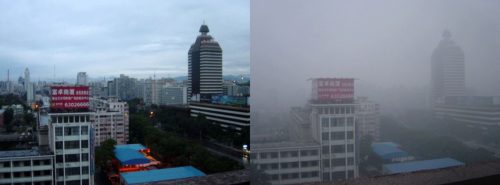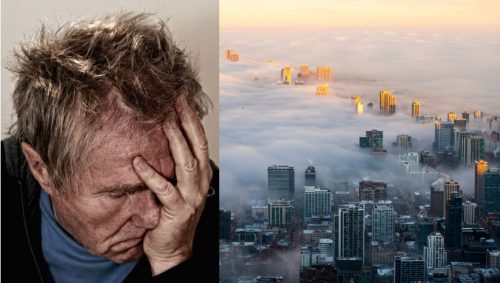Air pollution includes the release of chemicals and particulates into the atmosphere. We also call it atmospheric pollution. Some gasses that we class as pollutants include nitrogen oxides, CFCs, sulfur dioxide, and carbon monoxide. The letters CFCs stand for chlorofluorocarbons.
When nitrogen oxides and hydrocarbons react to sunlight, they create ozone and smog.
According to the Environmental Pollution Centers, air pollution can be defined in two parts:
- It is the occurrence of toxic chemicals or compounds, including those naturally occurring, in the atmosphere at concentrations that endanger human health.
- In a broader sense, it refers to the introduction of substances that are not typically present in the air, leading to a deterioration of air quality and contributing to issues such as ozone layer depletion and global warming.
Air pollution is one type of pollution
Pollution refers to the presence of substances in the environment that are harmful or toxic. Toxic means poisonous. The substances, which we refer to as ‘pollutants,’ may be harmful to human health. May may also be harmful to other animals as well as plants.
Pollution exists when something harmful enters the environment faster than it can be dispersed.
The three main types are water, air, and land pollution. Water pollution refers to the contamination of, for example, oceans, groundwater, aquifers, lakes, and rivers.

Air pollution and the weather
According to the British Lung Foundation, air pollution levels can change depending on the weather and time of year.
In the summer, for example, on a still day, it is more difficult for airborne pollutants to disperse. Therefore, concentrations of particulates or toxic substances tend to rise significantly. In foggy winter days, air quality can deteriorate for the same reason.
Air pollution – the result of human activity
In most cases, air pollutants are anthropogenic. In other words, they originate from human activity. Some air pollutants may be natural. Volcanoes, for example, emit natural pollutants into the atmosphere when they erupt.
Human activities such as construction, transportation, industrial production, and mining pollute our atmosphere significantly. Agriculture is also responsible for some airborne pollutants.
Anthropogenic pollutants, unlike natural ones, do not come and go. In fact, emissions from human activity tend to get progressively worse.
Air pollution – human health
Air pollution harms all of us; some more than others. People who live in big cities often experience irritation of the respiratory tract. Some may also have a cough, runny nose, and itchy eyes when air quality is particularly bad.
For older adults, babies, young children, and people with asthma, however, air pollution can be life-threatening. People with chronic lung diseases have to stay indoors when air pollution levels are high.

Some studies have linked atmospheric pollution with a higher risk of developing cardiovascular diseases and several cancers.
It’s a serious public health threat. The World Health Organization reports that exposure to polluted air can lead to a wide range of health problems, from more frequent hospital visits to a higher risk of dying early. Each year, around 4.2 million people die prematurely due to breathing in polluted air, with many of those deaths tied to conditions like heart disease, stroke, lung cancer, chronic respiratory illnesses, and infections in young children.

Cause of deaths
The World Health Organization says that globally, air pollution accounts for:
- 43% of all deaths and disease from COPD (chronic obstructive pulmonary disease).
- 25% of all deaths and diseases from ischemic heart disease. Ischemic heart disease refers to heart problems caused by narrowed heart arteries.
- 24% of all deaths from stroke.
- 17% of all deaths from acute lower respiratory infection.
- 29% of all deaths and disease from lung cancer.
Air pollution and worker productivity
A study found that severe air pollution can reduce worker productivity. The research was carried out over more than a year in several Chinese factories. It found that sustained severe air pollution can directly impact worker output, with a 10 microgram per cubic meter increase in PM2.5 levels, maintained over 25 days, leading to a 1 percent drop in daily production. While the visible particles are a clear sign of pollution, they affect workers in multiple ways. These pollutants not only enter the lungs and bloodstream, but may also trigger psychological effects that affect a person’s mood and overall productivity.
